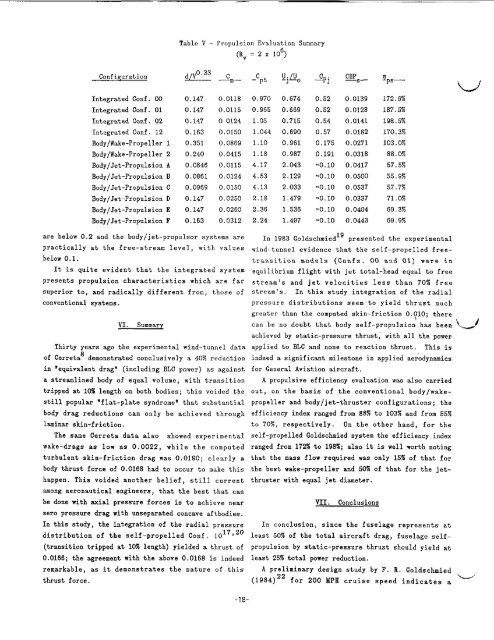Fuselage self-propulsion by static-pressure thrust - CAFE Foundation
Fuselage self-propulsion by static-pressure thrust - CAFE Foundation
Fuselage self-propulsion by static-pressure thrust - CAFE Foundation
You also want an ePaper? Increase the reach of your titles
YUMPU automatically turns print PDFs into web optimized ePapers that Google loves.
Configuration<br />
Integrated Conf. 00<br />
Integrated Conf. 01<br />
Integrated Conf . 02<br />
Integrated Conf. 12<br />
Body/Wake-Propeller 1<br />
Bady/Wake-Propeller 2<br />
Body/Jet-Propulsion A<br />
Body/Jet-Propulsion B<br />
Body/Jet-Propulsion C<br />
Body/Jet-Propulsion D<br />
Body/Jet-Propulsion E<br />
Body/Jet-Propulsion F<br />
Table V - Propulsion Evaluation Summary<br />
=2rlO)<br />
6<br />
0.33<br />
d/Y Lm-<br />
0.147 0.0118<br />
0.147 0.0115<br />
0.147 0 0124<br />
0.163 0.0150<br />
0.351 0.0869<br />
0.240 0.0415<br />
0.0846 0.0115<br />
0.0861 0.0124<br />
0.0969 0.0150<br />
0.147 0.0250<br />
0.147 0.0260<br />
0.163 0.0312<br />
among aeronautical engineers, that the best that can<br />
be done with axial <strong>pressure</strong> forces is to achieve near<br />
zero <strong>pressure</strong> drag with unseparated concave aftbodies.<br />
In this study, the integration of the radial <strong>pressure</strong><br />
17,20<br />
distribution of the <strong>self</strong>-propelled Conf. 10<br />
(transition tripped at 10% length) yielded a <strong>thrust</strong> of<br />
0.0166; the agreement with the above 0.0168 is indeed<br />
remarkable, as it demonstrates the nature of this<br />
<strong>thrust</strong> force.<br />
- C pt VjD0<br />
0.970 0.674<br />
0.965 0.669<br />
1.05 0.715<br />
1.044 0.690<br />
1.10 0.961<br />
1.18 0.987<br />
4.17 2.043<br />
4.53 2.129<br />
4.13 2.033<br />
2.18 1.479<br />
2.36 1.536<br />
2.24 1.497<br />
-Pj G - CHPS_<br />
0.52 0.0139<br />
0.52 0.0128<br />
0.54 0.0141<br />
0.57 0.0182<br />
0.175 0.0271<br />
0.191 0.0318<br />
-0.10 0.0417<br />
-0.10 0.0500<br />
"0.10 0.0537<br />
"0.10 0.0337<br />
-0.10 0.0404<br />
"0.10 0.0443<br />
Ips-<br />
172.6%<br />
187.5%<br />
198.5%<br />
170.3%<br />
103.0%<br />
88.0%<br />
57.5%<br />
55.9%<br />
57.7%<br />
71.0%<br />
69.3%<br />
69.9%<br />
are below 0.2 and the body/jet-propulsor systems are In 1983 Goldschmied" presented the experimental<br />
practically at the free-stream level, with values wind-tunnel evidence that the <strong>self</strong>-propelled freebelow<br />
0.1.<br />
transition models (Confs. 00 and 01) were in<br />
It is quite evident that the integrated system equilibrium flight with jet total-head equal to free<br />
presents <strong>propulsion</strong> characteristics which are far stream's and jet velocities less than 70% free<br />
superior to, and radically different from, those of stream's. In this study integration of the radial<br />
conventional systems.<br />
<strong>pressure</strong> distributions seem to yield <strong>thrust</strong> much<br />
greater than the computed skin-friction O.?lO; there<br />
VI. Summarl:<br />
can be no doubt that body <strong>self</strong>-<strong>propulsion</strong> has been<br />
achieved <strong>by</strong> <strong>static</strong>-<strong>pressure</strong> <strong>thrust</strong>, with all the power<br />
Thirty years ago the experimental wind-tunnel data applied to BLC and none to reaction <strong>thrust</strong>. This is<br />
of Cerreta' demonstrated conclusively a 40% reduction indeed a significant milestone in applied aerodynamics<br />
in "equivalent drag" (including BLC power) as against for General Aviation aircraft.<br />
a streamlined body of equal volume, with transition A propulsive efficiency evaluation was also carried<br />
tripped at 10% length on both bodies; this voided the out, on the basis of the conventional badylwakestill<br />
popular "flat-plate syndrome" that substantial propeller and body/jet-<strong>thrust</strong>er configurations; the<br />
body drag reductions can only be achieved through efficiency index ranged from 88% to 103% and from 55%<br />
laminar skin-friction.<br />
to 70%, respectively. On the other hand, for the<br />
The same Cerreta data also showed experimental <strong>self</strong>-propelled Goldschmied system the efficiency index<br />
wake-drags as low as 0.0022, while the computed ranged from 172% to 198%; also it is well worth noting<br />
turbulent skin-friction drag was 0.0190; clearly a that the mass flow required was only 15% of that for<br />
body <strong>thrust</strong> force of 0.0168 had to occur to make this the best wake-propeller and 50% of that for the jethappen.<br />
This voided another belief, still current <strong>thrust</strong>er with equal jet diameter.<br />
-18-<br />
YII. Conclusions<br />
In conclusion, since the fuselage represents at<br />
least 50% of the total aircraft drag, fuselage <strong>self</strong>-<br />
<strong>propulsion</strong> <strong>by</strong> <strong>static</strong>-<strong>pressure</strong> <strong>thrust</strong> should yield at<br />
'W<br />
least 25% total power reduction.<br />
A preliminary design study <strong>by</strong> F. R. Goldschmied<br />
(1984)" for 200 MPE cruise speed indicates a u

















